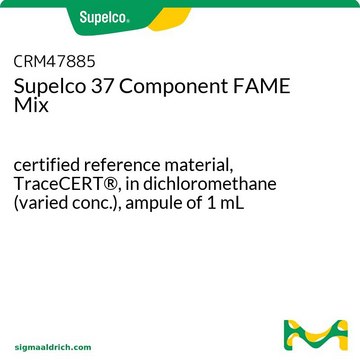Kluczowe dokumenty
W245115
Ethyl palmitate
natural (US), ≥95%, FG
Synonim(y):
Ethyl hexadecanoate, Palmitic acid ethyl ester
About This Item
Polecane produkty
klasa czystości
FG
Fragrance grade
Halal
Kosher
natural (US)
agency
follows IFRA guidelines
zgodność regionalna
EU Regulation 1223/2009
EU Regulation 1334/2008 & 178/2002
FDA 21 CFR 117
Próba
≥95%
współczynnik refrakcji
n20/D 1.440 (lit.)
bp
192-193 °C/10 mmHg (lit.)
mp
24-26 °C (lit.)
gęstość
0.857 g/mL at 25 °C (lit.)
Zastosowanie
flavors and fragrances
Dokumentacja
see Safety & Documentation for available documents
alergen pokarmowy
no known allergens
alergen zapachowy
no known allergens
Organoleptyczne
creamy; milk; fruity; waxy
ciąg SMILES
CCCCCCCCCCCCCCCC(=O)OCC
InChI
1S/C18H36O2/c1-3-5-6-7-8-9-10-11-12-13-14-15-16-17-18(19)20-4-2/h3-17H2,1-2H3
Klucz InChI
XIRNKXNNONJFQO-UHFFFAOYSA-N
Szukasz podobnych produktów? Odwiedź Przewodnik dotyczący porównywania produktów
Kod klasy składowania
10 - Combustible liquids
Klasa zagrożenia wodnego (WGK)
WGK 3
Temperatura zapłonu (°F)
Not applicable
Temperatura zapłonu (°C)
Not applicable
Wybierz jedną z najnowszych wersji:
Masz już ten produkt?
Dokumenty związane z niedawno zakupionymi produktami zostały zamieszczone w Bibliotece dokumentów.
Nasz zespół naukowców ma doświadczenie we wszystkich obszarach badań, w tym w naukach przyrodniczych, materiałoznawstwie, syntezie chemicznej, chromatografii, analityce i wielu innych dziedzinach.
Skontaktuj się z zespołem ds. pomocy technicznej







